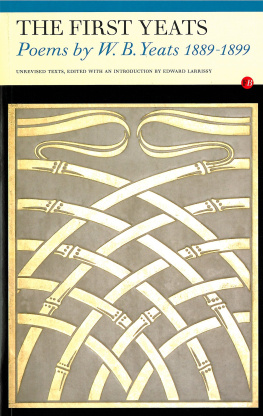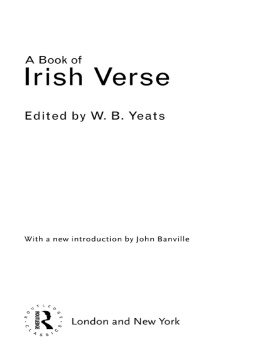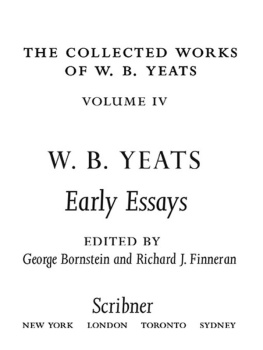
THE COLLECTED WORKS
OF W. B. YEATS
VOLUME IX
THE COLLECTED WORKS OF W. B. YEATS
Richard J. Finneran and George Mills Harper, General Editors
V OLUME I T HE P OEMS
ed. Richard J. Finneran
V OLUME II T HE P LAYS
ed. David R. Clark and Rosalind E. Clark
V OLUME III A UTOBIOGRAPHIES
ed. William H. ODonnell and Douglas Archibald
V OLUME IV E ARLY E SSAYS
ed. Warwick Gould and Dierdre Toomey
V OLUME V L ATER E SSAYS
ed. William H. ODonnell
V OLUME VI P REFACES AND I NTRODUCTIONS
ed. William H. ODonnell
V OLUME VII L ETTERS TO THE N EW I SLAND
ed. George Bornstein and Hugh Witemeyer
V OLUME VIII T HE I RISH D RAMATIC M OVEMENT
ed. Mary FitzGerald and Richard J. Finneran
V OLUME IX E ARLY A RTICLES AND R EVIEWS
ed. John P. Frayne and Madeleine Marchaterre
V OLUME X L ATER A RTICLES AND R EVIEWS
ed. Colton Johnson
V OLUME XI M YTHOLOGIES
ed. Warwick Gould and Dierdre Toomey
V OLUME XII J OHN S HERMAN AND D HOYA
ed. Richard J. Finneran
V OLUME XIII A V ISION (1925)
ed. Margaret Mills Harper and Catherine Paul
V OLUME XIV A V ISION (1937)
ed. Margaret Mills Harper and Catherine Paul
Early Articles and Reviews
UNCOLLECTED ARTICLES
AND REVIEWS WRITTEN BETWEEN
1886 AND 1900
W. B. YEATS

EDITED BY
John P. Frayne Madeleine Marchaterre
Scribner
NEW YORK LONDON TORONTO SYDNEY

SCRIBNER
1230 Avenue of the Americas
New York, NY 10020
www.SimonandSchuster.com
Compilation copyright 2004 by Michael Yeats
Preface and notes copyright 2004
by John P. Frayne and Madeleine Marchaterre
All rights reserved, including the right of reproduction in whole or in part in any form.
SCRIBNER and design are trademarks of Macmillan Library Reference USA, Inc., used under license by Simon & Schuster, the publisher of this work.
For information about special discounts for bulk purchases, please contact Simon & Schuster Special Sales: 1-800-456-6798 or business@simonandschuster.com
Text set in Sabon
Manufactured in the United States of America
1 3 5 7 9 10 8 6 4 2
Library of Congress Cataloging-in-Publication Data
Yeats, W. B. (William Butler), 1865-1939.
Early articles and reviews : uncollected articles and reviews written between 1886 and 1900 / W. B. Yeats ; edited by John P. Frayne and Madeleine Marchaterre.
p. cm.(The collected works of W. B. Yeats ; v. 9)
Includes bibliographical references (p. ) and index.
I. Frayne, John P. II. Marchaterre, Madeleine. III. Title.
PR5900.A2 F56 1989 vol. 9
[PR5902]
824.8dc22 2003063312
ISBN 0-684-80730-0
eISBN: 978-1-451-60304-0
CONTENTS
PREFACE AND ACKNOWLEDGMENTS
This volume collects those articles and reviews which Yeats did not publish in book form, nor were they collected and published by Mrs. Yeats after Yeatss death. The chronological scope of this volume goes from 1886, the year of the appearance of Yeatss first prose pieces, to the end of 1899. Articles which appeared after 1899 are collected in the companion volume, Later Articles and Reviews, edited by Colton Johnson.
Most of the material in this volume was published in Uncollected Prose, vol. 1 (1971), and Uncollected Prose, vol. 2 (1975). Added to the pieces already in print are early articles written for The Gael as well as more recently identified reviews such as those for G. E. Lelands Gypsy Sorcery and George Sigersons anthology Bards of the Gael and Gall.
Pruned from UP1 and UP2 were a number of pieces which went into other, more appropriate, volumes of The Collected Works of W. B. Yeats. Two pieces for The Providence Sunday Journal went into Letters to the New Island, a few short stories will appear in The Celtic Twilight and The Secret Rose, letters to newspapers went into The Collected Letters, and some accounts of lectures await their fate.
Yeats expressed great fascination, even enthusiasm when Horace Reynolds collected his American newspaper pieces for publication in 1934. In a letter to Reynolds on 24 December 1932, Yeats expressed some reservations about his early propaganda for the Irish Literary Movement. However, there is evidence that Yeats wished to collect some prose pieces into more permanent form. Irish Rakes and Duelists was to be part of a book on the Irish past in the Adventurers series. His four articles on Irish National Literature for The Bookman were intended to become a pamphlet, but the plan came to nothing. His six articles on Irish folklore (four of which are in this volume, the last two in Later Articles and Reviews) were intended to be part of a collaboration with Lady Gregory which just did not work out. Lady Gregory did publish two volumes, Visions and Beliefs in the West of Ireland, based on the material which she had collected with Yeats, and Yeats contributed two essays and notes to that volume.
In these articles and reviews, we can trace the development of some of Yeatss leading ideas on Irish nationalism and literature, on the occult, on folklore, and also on the place where Yeats saw himself and his contemporaries in the evolution of English and European literature as well as in the revival of Irish literature. Yeatss judgments sometimes bear the marks of youthful rashness and daring. From these qualities comes a certain charm which might have been softened or toned down by revisions had Yeats edited his work later in life.
In his reviews, we have primary evidence of Yeatss interaction with his Irish and English contemporaries: Katharine Tynan, AE, Douglas Hyde, John Todhunter, as well as Oscar Wilde, Arthur Symons, Lionel Johnson, and Ernest Rhys. To the daily or weekly reviewer does not fall the privilege of the leisurely appraisal of the great literature of the age. He or she must shoot from the hip at whatever targets are offered. Of some of Yeatss reviews it could be said that what ideas the book inspired in Yeats are of greatly more importance than the original volumes under review.
The immediate inspiration for these pieces was financial, and there is ample evidence in Yeatss letters to show how much he needed the money that magazines could pay. Yet at the same time Yeats seemed to have thoroughly enjoyed himself. He loved sounding boards for his ides fixes, and anything having to do with Ireland, Irish literature, or William Blake brought out the evangelist in him. To say that this was hack work obscures the whole truth. To be sure, there were deadlines, odd assignments, restrictions in length and perhaps treatment, but Yeats seemed to welcome occasions which could induce inspiration, rather than the opposite.
The conventional wisdom is that financial help from Lady Gregory rescued Yeats from the drudgery of journalism. If the purpose of this rescue was to return Yeatss energies to poetry, the help had a somewhat ironic effect. With Lady Gregorys collaboration, Yeatss energies went more and more into the Abbey Theatre, an activity (among others) of which Yeats spoke with exasperation, All things can tempt me from this craft of verse.
Next page









